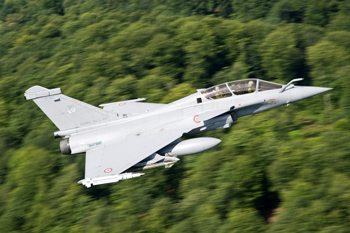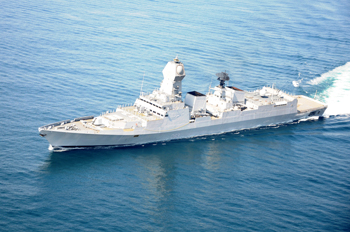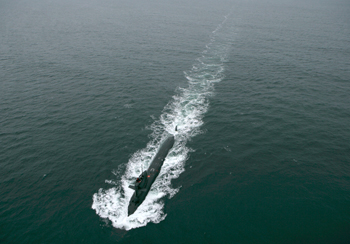INDIAN ARMED FORCES CHIEFS ON OUR RELENTLESS AND FOCUSED PUBLISHING EFFORTS

The insightful articles, inspiring narrations and analytical perspectives presented by the Editorial Team, establish an alluring connect with the reader. My compliments and best wishes to SP Guide Publications.

"Over the past 60 years, the growth of SP Guide Publications has mirrored the rising stature of Indian Navy. Its well-researched and informative magazines on Defence and Aerospace sector have served to shape an educated opinion of our military personnel, policy makers and the public alike. I wish SP's Publication team continued success, fair winds and following seas in all future endeavour!"

Since, its inception in 1964, SP Guide Publications has consistently demonstrated commitment to high-quality journalism in the aerospace and defence sectors, earning a well-deserved reputation as Asia's largest media house in this domain. I wish SP Guide Publications continued success in its pursuit of excellence.
- Operation Sindoor: Resolute yet Restrained
- India’s Operation Sindoor Sends a Clear Message to Terror and the World – ‘ZERO TOLERANCE’
- Japan and India set forth a defence cooperation consultancy framework, talks on tank and jet engines
- Terrorist Attack in Pahalgam in Kashmir: Unfolding a long surgical war against PAK
- Lt General Pratik Sharma takes over Command of Indian Army's Northern Command
All air and no substance
Next month the government will completing one year in office. That defence was the most neglected sector over the past decade is an established fact, much to the glee of our adversaries; without a national security strategy and comprehensive defence review, military holding 50 percent obsolete equipment, indigenous defence production at the lowest nadir meeting about 30 percent of overall needs albeit through substandard equipment. So let us take a look as to what has happened after change of government. Yes, there has been much in the media but how much it is substance and how much is gas?
 |
By Lt. General P.C. Katoch (Retd) Former Director General of Information Systems, Indian Army |



There has been plenty hype about ‘make in India’ but as far as the defence sector is concerned the Defence Minister let the cat out of the bag that the policies and procedures for defence procurement need changes – which has been known for decades. Should this not have been priority? It is being said that new policy will be out in 2-3 months, which will likely have cosmetic changes like previous years because it is being evolved as always ‘in-house’. Take a look at the other side of the coin about ‘Make in India’. Why are companies, that are already sharing their activities with DPSUs contributing to more that 50 of the overall indigenous output or even more through smooth and successful results being penalized due to lack of decision to go ahead, with a number of contracts that are waiting decision to be taken somewhere along the bureaucratic channels? Take the case of Offset Banking. A million Euros have been requested by companies for purchasing High Technology material from India that would benefit both but then why are they still waiting endlessly for someone to clear the banking. Tenders kept by the previous government in cold storage are still waiting more than one year, some examples of which are the Scorpene class submarines where decisions are pending. Admittedly, the Navy is not adverse to weapon systems being added post launch, as has happened in case of INS Kolkatta. But do we plan to induct the Scorpene class submarines for sub surface operations without weaponry in an environment of Chinese nuclear submarines milling around and Pakistan planning to put tactical nuclear weapons on her diesel submarines? Then is the MMRCA without a decision and hanging fire in the CNC stage. The tender for the Light Utility Helicopter has been scrapped despite severe shortages in the Army and Air Force. Yes, there is plenty in the news about indigenous development of aircraft and helicopters but these are long-term projects. And let us not fool ourselves by putting in the media that two indigenous AWACS will be developed in 5-7 years. Let us first induct the Tejas before such glib talk. Incidentally, we were to have our own GPS with seven satellites up by 2012 but have managed to launch the fourth satellite only in 2015. We may trumpet come invest their technologies in India, but are we looking at why to finalize a tender it takes 7-8 years and what advantage do JVs give an investor in terms of timing and potental contract as L1? The fact is that the whole show is not about “India First” but “Bureaucracy First”. Private Sector says anybody can say anything against you and you are dead, until you are not able to demonstrate to the contrary (remember the infamous IMDT Act of Assam?), but in the mean time your reputation is destroyed and also business, and in addition the one who created such mess is promoted to other responsibility. Business oriented companies cannot wait that long to recover investments made in India. Imagine the frustration of foreign companies that are completely blind in all the steps where bureaucracy is involved. You can stay years without information about your offers. You write letters but you are ignored. Bureaucracy prevails, hype of authorizing agent notwithstanding! The bottom-line is that the overall diffused opinion is negative because despite the declared intentions to rectify the lack of previous management, like timing in the acquisition process, extension to private companies for tenders etc, nothing much has happened. While deep changes are required to attract foreign investors, the state of equipping of the Indian Military remains dismal. Defence of India needs substance not gas.





